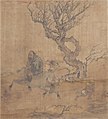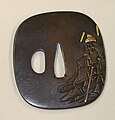Zhong Kui
| Zhong Kui | ||
|---|---|---|
Hanyu Pinyin Zhōng Kuí | | |
| Wade–Giles | Chung K‘uei Chung Kwei | |
| Transcriptions | |
|---|---|
| Revised Romanization | Jong-gyu |
| Transcriptions | |
|---|---|
| Romanization | Shōki |
Zhong Kui (
In art, Zhong Kui is a frequent subject in paintings and crafts, and his image is often painted on household gates as a guardian spirit as well as in places of business where high-value goods are involved. He is also commonly portrayed in popular media.
King of ghosts
According to folklore, Zhong Kui travelled with Du Ping (杜平), a friend from his hometown, to take part in the state-wide imperial examinations held in the capital city Chang'an. Though Zhong Kui attained great academic success through his achievement of top honors in the major exams, his rightful title of "Zhuangyuan" (top-scorer) was stripped from him by the then emperor because of his disfigured and ugly appearance.[1]
Extremely enraged, Zhong Kui committed suicide by continually hurling himself against the palace gates until his head was broken, whereupon Du Ping had him buried and laid to rest. During the divine judgment after his death from suicide,
After Zhong Kui became the king of ghosts in Hell, Zhong Kui returned to his hometown on Chinese New Year's eve. To repay Du Ping's kindness, Zhong Kui gave his younger sister in marriage to Du Ping.[2]
Popularization in later dynasties
Zhong Kui's popularity in folklore can be traced to the reign of
Legacy
Zhong Kui and his legend became a popular theme in later Chinese painting, art, and folklore. Pictures of Zhong Kui used to be frequently hung up in households to scare away ghosts. His character was and still is especially popular in New Year pictures.[4]
Moreover, the popularity of Zhong Kui gives rise to the idiom "Da Gui Jie Zhong Kui" (打鬼借钟馗), which could be translated as "Borrow the name of Zhong Kui to smash the ghost", which means to finish a task by masquerading it is done for someone greater in power or status. Some argue that Mao Zedong is the first to use this phrase.[5]
In art
Twentieth-century painter Quan Xianguang (b. 1932) painted Zhong Kui as a burly, hairy man holding a sturdy sword in his bared right arm.[6]
-
Dai Jin's The Night Excursion of Zhong Kui (15th century), depicting Zhong Kui undertaking a night patrol while being carried in a sedan chair by four demons
-
Wen Zhengming's Zhong Kui in a Wintry Grove (Ming dynasty), matching Ge Hong's Master Embracing Simplicity that states that ominous creatures often haunted forests, which is why Zhong Kui is needed there
-
Zhong Kui and Spiders by Zhou Xun (1649–1729), depicting Zhong Kui eyeing spiders dangling down from above (a rebus or auspicious pun for 'joyful things')
-
Ren Yi's Zhong Kui (1883), in which Zhong Kui appears as an elegant but somewhat eccentric scholar, with his sword sheathed and a blossom in his hair, as he decorously reads
-
Auspicious Omen of Abundant Peace (Qing dynasty), humorously depicting Zhong Kui being shocked as he looks at his grotesque visage in the mirror
-
Zhong Kui is seen waving his sword at five bats representing thefive blessings, as if symbolically bringing these fortunes down to someone as recipient, depicted in a late 19th or early 20th century xylograph
-
Zhong Kui, the Demon Queller (17th century), in which Zhong Kui rides an ox while quelled demons carry his sword or lead his ox
-
A 16th-century painting, depicting a seated Zhong Kui
-
A 17th-century painting by Lu Xue, depicting Zhong Kui with demons
-
A painting by the Shunzhi Emperor (r. 1643–1661) of the Qing dynasty
-
A detail of Okumura Masanobu's Shōki zu (Shōki striding), dated c. 1741–1751.
-
Fei Danxu's Zhong Kui and his Assistants Under Willows (1832), depicting Zhong Kui and his demon helpers
-
Zhong Kui by Min Zhen (1730–after 1791), depicting Zhong Kui riding a quadrupedal creature
-
A 1776 painting by Min Zhen, in which Zhong Kui sits and leans on a chair
-
Zhong Kui and Demons Crossing a Bridge (16th century), depicting Zhong Kui on a donkey
-
Zhong Kui Appreciating Plum Blossom (18th century)
-
Coppertsubadepicting Shōki, by Masayuki Tsuba (1695-1769)
Temples
- Zhong Kui Temple (钟馗庙) in Guanqiao, Hunan
- Shuiwei Zhengwei Temple (水尾震威宮) in Xizhou, Changhua
- Guang Lu Temple (光祿廟) in Zhuqi, Chiayi
- Wu Fu Temple (五福宮) in Wanhua, Taipei
- Zhong Nan Old Temple (終南古廟), Batu Pahat, Johor
- Shōki Shrine (鍾馗神社) in Higashiyama Ward, Kyoto
In popular culture

- Zhong Kui is venerated in Chinese folk religion as one of the three Lords of Demon-Subduer (三伏魔帝君) in Southern China region. Xuan Tian Shang Di and Guan Sheng Di Jun (Guan Yu) are the other two Lords.
- The Dance of Zhong Kui (跳鐘馗)
- Shōki is highly venerated in Japan and is still worshipped in some Shinto shrines. Shōki was also the namesake of the Imperial Japanese Army's single-engine Nakajima Ki-44fighter plane.
- Zhong Kui (played by San Kuai) appears in the 1977 Bruceploitation film The Dragon Lives Again.
- Zhong Kui appears in the 1985 Taiwanese series New Legends of Chu Liuxiang
- Qiu Yun, the main character of Huang Shuqin's 1987 feminist film Woman, Demon, Human, is an opera singer famed for her portrayals of Zhong Kui.
- Zhong Kui (played by Huang Wenyong) appears in the 1987 Strange Encounters and its 1988 sequel Strange Encounters II.
- Zhong Kui (played by Law Lok Lam) appears in the 1988 Asia Televisionseries The Chinese Ghostbuster.
- Zhong Kui appears in the Hong Kong comic Saint and, as Shōki, in the American comic Usagi Yojimbo.
- Zhong Kui is the main character in the 1994 Taiwanese–Singaporean television series Heavenly Master Zhong Kui (《天師鍾馗》, Tianshi Zhong Kui).
- Zhong Kui (played by Wu Ma) is the main character in the 1994 Hong Kong film The Chinese Ghostbuster.
- Zhong Kui appears as a summonable demon in the 1995 RPG Shin Megami Tenseititles.
- Pierre DeCelles created a Zhong Kui series of paintings in 2004.
- Zhong Kui (played by Bobby Au-yeung) is the main character of the 2009 series Ghost Catcher: Legend of Beauty.
- Zhong Kui is the main character in the 2012 Hunan Television series The Legend of Zhong Kui (《鍾馗傳說》, Zhōng Kuí Chuánshuō).
- Zhong Kui (played by Chen Kun) is the main character in the 2015 movie Zhong Kui: Snow Girl and the Dark Crystal.
- Zhong Kui "the Demon Queller" is a character from the MOBA game Smite.
- Zhong Kui in the 2015/2023 MOBA game Honor of Kings(王者荣耀) as a support hero.
- Zhong Kui appears as a character in the 2018 novel Voice of the Elders by Greg Ripley.
- Zhong Kui appears as a DLC character in Crytek's 2018 survival game Hunt: Showdown.
- Zhong Kui appears in the 2020-2021 Taiwanese fantasy drama series The Devil Punisher.
- In the 2022 mobile game Dislyte, Zhong Nan is an Epic Esper with the powers of Zhong Kui.
See also
- Cheng Huang Gong, Chinese City God
- Chinese numismatic charm
- Fulu
- Hei Bai Wu Chang, Chinese constables of underworld
- Imperial examination in Chinese mythology
- Kui in Chinese mythology
- Menshen, Chinese Door Gods
- The Five Poisons
- Yanluo Wang, Chinese Underworld Judge
References
- ^ 刘, 锡诚. "[刘锡诚]钟馗传说和信仰的滥觞 · 中国民俗学网-中国民俗学会 · 主办 ·". www.chinafolklore.org. Retrieved 11 February 2023.
- ISBN 978-81-7488-156-4. Retrieved 7 June 2013.
- ISBN 978-0-520-92877-0. Retrieved 7 June 2013.
- ^ ISBN 0-7007-0439-6.
- ^ 吴, 志菲. "毛泽东对"个人崇拜"的态度演变【3】--党史频道-人民网". dangshi.people.com.cn. Retrieved 11 February 2023.
- ^ Shelagh Vainker and Xin Chen, editors, A Life in Chinese Art: Essays in Honor of Michael Sullivan, p. 83.
- ISBN 9789867614285.
External links
 Media related to 鍾馗 at Wikimedia Commons
Media related to 鍾馗 at Wikimedia Commons

















